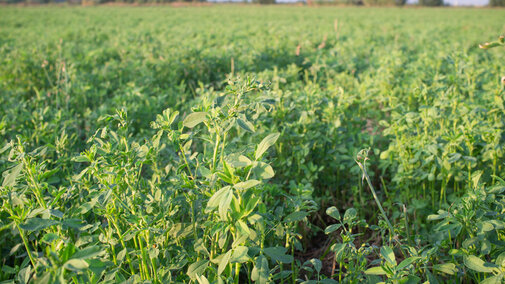Replacing Thin Alfalfa
Planting new fields of alfalfa is expensive, so many of us put off tearing up old fields and planting new ones. But is this smart?
Alfalfa stands usually reach peak production by year two or three. After this, yields tend to decline each year. By year four or five, yields are often much lower than their peak years — especially for dryland fields, because the subsurface moisture that plants were using during the early years is all gone. This is most noticeable during drought years when regrowth is almost zero after the first or second cut.
Yield decline in irrigated fields is slower but usually is a ton or more lower by year five or six.
In addition, thin stands with densities of less than 50 stems per square foot can open the door for weed encroachment.
So, should you try to squeeze another year out of your current alfalfa stand? Calculate the costs. First, and most obvious, how will the lower yield of your old field compare to yields from a younger field?
A second loss is the lost rotation benefit received by crops like corn that follow alfalfa in the rotation. Not only will alfalfa reduce your nitrogen fertilizer needs by 100-150 pounds over the next couple years, much research has shown that corn after alfalfa often yields 10 to 20 bushels more per acre than it will even with extra fertilizer.
This rotation benefit could be especially valuable this year if commodity and fertilizer prices stay high. So if you have alfalfa fields that are past their prime, or maybe show winter damage this spring, this might be an excellent time to rotate those fields to a different crop and plant some new, higher yielding acres to alfalfa.
Both your alfalfa crop and the rotated crop could benefit.
Grass-Alfalfa Mixtures or Pure Alfalfa
By Brad Schick
Planting a new alfalfa hay field is a pretty routine undertaking. Have you considered putting some grass in that new alfalfa planting this year?
Putting a field back into alfalfa is a practice that often goes with little thought of alternative species. Every operation is different, so pure alfalfa may still be the best option. Some producers may want to seed smooth bromegrass, orchardgrass, festulolium or other grasses with the alfalfa. But why should you consider a mixture?
Many producers roll out bales for winter feeding, while others may grind different hays or feedstuffs. If more than five to six pounds of alfalfa is being fed to brood cows, that may be too little energy or TDN and too much protein. This is with a good quality alfalfa.
If an alfalfa-grass hay is fed instead, the protein may be lower, but the TDN will be higher and better meet the energy requirements of those cows while not overfeeding protein. The mixing of the hay is done in the field while it grows instead of with the machinery in the winter.
Not every field is equal — just look at a soil map. Soil types or conditions may vary within a field and a mixture may result in a better overall stand. Alfalfa, for example, doesn’t like “wet feet” so the grass planted will do better in low lying areas where alfalfa can’t survive. Additionally, an alfalfa-grass mix usually dries down more quickly so it can get put up sooner. Typically, a mixture will yield the same or more than pure alfalfa on an annual basis, with most of the grass tonnage produced in the first cutting.
Mixtures do have to be managed differently than pure alfalfa stands, and some buyers may only want alfalfa, but for some operations, a mixture might be the perfect recipe.

